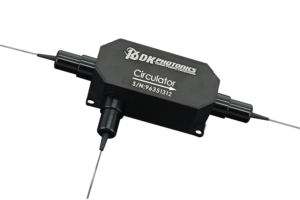A PM circulator is a special optical passive component that can be used for different purposes in fiber optics applications. If you are looking for a guide to learn about what a PM circulator is, how it works and where it is used, then this guide is perfect for you as we are going to discuss the same here. So, without any delay, let’s learn all the basics of a PM circulator.

What is a PM circulator?
A polarization-maintaining (PM) circulator is an optical circulator that is basically a non-reciprocal device used to route the light from one fiber to another depending on the direction of propagating light signals. The main difference between a PM circulator and an optical circulator is that a PM circulator does it all while maintaining the polarization state of the light beam.
Typically, it has at least three ports that are designed in a way that the light that enters any port exits from the next. Though you may also find four-port PM optical circulators, 3-port PM circulators are the most commonly used optical circulators in the industry. In a 3-port circulator, the two ports act as input ports, and one port acts as an output port.
The main purpose of using PM circulators is to separate the light signals that propagate in opposite directions in an optical fiber without disturbing the polarization state of the light signals. Hence, by implementing PM circulators, one can achieve bi-directional transmission over a single fiber.
Salient Features of PM Circulators
- High isolation
- Low insertion loss
- Excellent temperature and environment stability
- Low polarization dependent loss
- Low polarization mode dispersion
PM circulators that come with the capability of handling high power are generally called high-power PM circulators.
While some optical circulators are full circulators in which the light signals from port 3 are transmitted to port 1 (making a complete circle), other optical circulators are quasi-circulators in which light signals from port 3 are lost and cannot travel back to port 1.
How does a PM Circulator work? What is its working principle?
As mentioned above, PM circulators are passive light-wave components that are primarily used to direct the optical signal from one port to another and ensure that the propagation of light signal remains in one direction only. This way, one can prevent the signal from traveling in an unintended direction, which often occurs in the case of reflected signals.
In a 3-port PM circulator, the incoming optical signal is routed from port 1 to port 2 and the incoming (reflected) Port 2 signals are redirected to port 3 instead of port 1. All this is done while maintaining the polarization state of the light signal.
In doing so, the circulator allows you to achieve bi-directional transmission in a single fiber. Since the light signal is circulating and the polarization state is maintained, the device is named as a PM optical circulator.
What are the uses and applications of PM circulators?
- PM circulators are most often used to achieve bi-directional optical signal transmission over a single fiber to attain high efficiency and isolation.
- They are also used as key components in passive optical networks, WDM networks, and fiber sensing applications.
- These circulators are also used in polarization mode dispersion, chromatic dispersion compensation, OADM modules, pump laser source, and optical amplifiers.
- Due to their excellent features, these circulators are also commonly used in advanced communication systems, instrumentation, and fiber optics technologies.
DK Photonics is the leading China-based manufacturer and supplier of non-PM and PM circulators in China. Whether it is a small order for a research project or a bulk order, the company is always ready to fulfill all types of orders with standard as well as customized specifications. For any queries related to optical circulators, please get in touch with us.

Leave A Comment